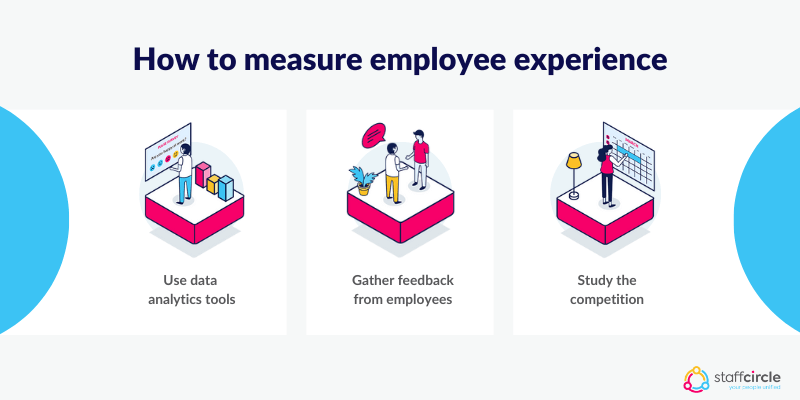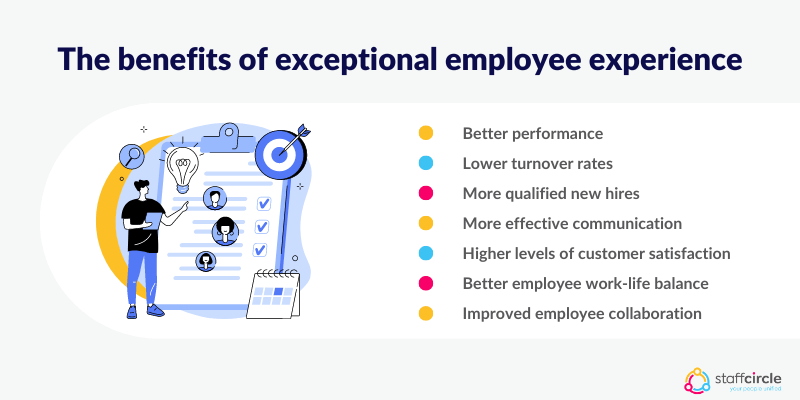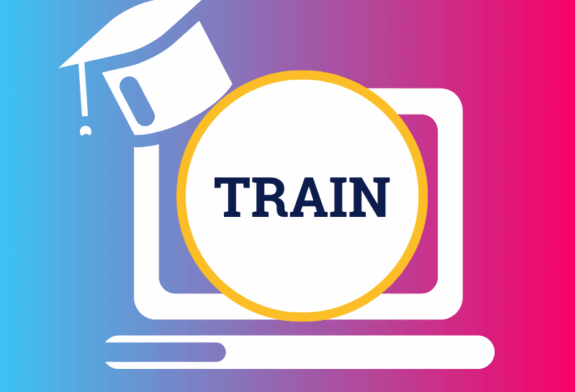Employee experience begins the moment a candidate accepts a role in a company, continuing up until they conduct their exit interview. This creates a broad range of touchpoints where business leaders can work to create a positive employee experience, enhancing productivity, engagement, and staff loyalty.
Read on to discover how you can craft a people strategy focused on employee experience. Learn how to build teams and departments of A-players who are committed to seeing your organisation succeed.
What is Employee Experience?
The employee experience, sometimes referred to as EX, relates to the broad range of interactions and touchpoints that help define how an employee feels about their time with the company. It can be measured throughout every stage of the employee lifecycle, from their onboarding experience and sense of career progression to the interactions they have with colleagues and managers.
In addition to these interactions, a positive employee experience is also shaped by their workspace and environment, both of which can have a significant impact on employee performance. The company’s culture and approach to technology can also help shape stronger employee satisfaction.
The most effective and successful companies understand the importance of working to craft the best employee experience possible. This is achieved through a wide range of processes and incentives, from intrinsic and extrinsic rewards to career development through lateral and vertical promotions.
Boost Retention by Improving Employee Experience
Discover the secrets to creating an irresistible workplace
What is the Importance of Employee Experience?
A great employee experience not only helps to nurture and retain the best talent but it can also be used to attract new employees capable of delivering the best results. It fosters a workplace where staff is enthusiastic about their work and is committed to doing it to a high standard.
When the employee experience is rewarding, employees become more engaged and motivated, building stronger relationships with their peers and working better in teams. The end result is employees who are proud of what they do and excited to be a part of the company.
As Josh Bersin expressed it in his article, The Crusade for Employee Experience: How Did We Get Here?
“Employee Experience is a company-wide initiative to help employees stay productive, healthy, engaged, and on track. It’s no longer an HR project. It is now an enterprise-wide strategy, often led by the CHRO in partnership with the CIO. And it deals with all the day-to-day issues employees face at work.”
As such, business leaders should work to create an environment that maximises a positive work experience for their employees. This also means putting in place employee feedback systems to identify negative employee experiences as early as possible so that managers and HR professionals can step in early and address their personal or professional problems.
Types of Employee Experience Surveys
An efficient way you measure the health of the employee experience in your organisation is through surveys. They can almost resemble routine check-ups to assess your health needs.
Different types of surveys can help understand specific employee needs in an organisation. For the best results, implementing and analyzing six important survey types can help:
Candidate Attraction Surveys
Understanding the impression of newcomers regarding recruitment interactions is critical to assessing their employment experience. In an age when companies are reeling from quiet quitting and The Great Resignation, this might seem like overkill. In reality, however, a candidate has already made up their mind on the organisation they are interviewing for within the first few minutes of the interview. A study by MarketSplash backs this up: 69% of people form an opinion about the other person before either person starts to talk.
But interview dynamics are very much tilted in favour of the employer, and getting raw feedback is highly improbable. This can be achieved, to some extent, by distributing brief surveys to job applicants with questions regarding the following aspects:
- Their overall experience of the hiring process
- The effectiveness of the communication systems
- Areas of strength or further development
This feedback survey can help employers shape their future approaches to recruitment.
New Hire Onboarding Surveys
The company can check in with new hires around different markers, such as their first month, two months, or three months. To conduct this, employers can take the help of surveys or interviews regarding:
- Are they clear on their role expectations
- Is the training process helpful
- The manager-employee relationship dynamics
- Areas in which they still require support
Onboarding surveys indicate how welcome the new employees feel and how well they are being prepared to add value to the company. Understanding their employment experience can help fine-tune the onboarding process in the organisation.
360-degree Feedback Surveys
The 360-degree feedback survey involves collecting information on an employee from their peers, managers, and direct reports to evaluate:
- Qualities of leadership
- Ability to collaborate
- Strengths and development needs in their work approach
- Their overall performance
360-degree feedback facilitates an all-encompassing visibility into the behaviour and skill gaps to guide leaders towards enhancing the experiences of team members.
Pulse Surveys
Real-time pulse surveys are brief surveys that evaluate an organisation’s management systems by asking for quick feedback on:
- Needs in the work environment
- Current and ongoing issues
- New policy rollouts
- Any decision inputs
A continued pulse survey can foster an organisation’s practice of dynamic listening and create an agile management system to address any emerging needs before problems can arise.
Annual Employee Engagement Surveys
An annual survey of employee engagement can assess all the key facets of workplace experience, such as:
- Sentiments regarding leadership, culture, and inclusion
- Access to autonomy and resources
- Performance and career development
- Dynamic with managers and team members
- Their overall employer experience in the organisation
Exit Surveys
Often, departing employees are the greatest source of insights regarding things that have been overlooked. Thus, exit surveys are important as they reveal:
- Primary causes for resignation
- Aspects that will be missed by employees
- Areas of improvement for the leadership
- Likelihood that the organisation will be recommended
Exit interviews and surveys often reveal mistakes made by the organisation that may be responsible for pushing talent out the door. Thus, issues will be revealed that can be patched by the management.
How to Measure the Impact of Employee Experience
Business leaders, HR professionals, and managers are in no position to improve the employee experience if they cannot measure their actions’ impact. In order to maximise the best courses of action, tools and processes are necessary to collate data for employee analytics and reports.
Use Data Analytics Tools
The article from the Harvard Business Review, In A Hybrid World, Your Tech Defines Employee Experience, outlines the link between tech and experience:
“The technology experiences that employers provide will more or less define the employee experience — technology and workplace tools are, for all intents and purposes, the new workplace. As such, they’re becoming central in attracting and retaining new talent, fostering workplace culture, creating productivity, and more.”
This data can also be used to measure a positive employee experience in a variety of ways. Performance data taken from objectives and key results (OKR) tracking can help pinpoint individuals, teams, and departments who are lagging behind in their performance.
This data will highlight those individuals and teams who are having low employee satisfaction, so managers and HR leaders can focus on addressing their issues. Additional one2one sessions and other targeted feedback processes can then be implemented through performance management software.

Gather Feedback From Employees
This technology is central to effectively measuring the impact of employee experience across a variety of measurements and work domains. Employee Net Promotor Scores (eNPS) and other employee surveys can be used to gain broad insights into company-wide trends relating to engagement and job satisfaction.
Culture feedback surveys can also be used to help identify any disconnect between the workforce and the company’s core mission and values. This can be essential for maintaining a healthy alignment between the business and its employees.
When employees feel as if they are working towards shared goals, they invest more time and effort in their professional development. This feedback can also help drive better training and development decisions at the team and departmental level and assist with coaching and mentoring.
Study the Competition
Finally, businesses can learn valuable lessons by observing the best practices of the leading companies, for instance, those featured on the Employee Experience Index. These approaches to creating a positive employee experience can help business leaders brainstorm new strategies to help improve their employer value proposition.
What is the Difference Between Employee Engagement and Employee Experience?
Increasing employee engagement is one of the main objectives of implementing a successful employee experience strategy. The definition of employee engagement incorporates employees’ commitment toward the company and their role and responsibilities. It also improves their relationships with others through regular and more meaningful interactions.
Strong and healthy engagement can have a huge positive impact on overall business outcomes. Various studies have demonstrated the link between engagement and positive financial results while at the same time helping to improve the mental and physical health and well-being of the workforce.
Recent data from Gallup suggests there is much to be done for companies to improve their employees’ experience through more robust engagement. Their report from 2022 indicates that just 21% of employees are engaged globally, with 19% of employees describing themselves as actively disengaged.
Here is a table detailing the comparison results between the two concepts:
| Factors | Employee Experience | Employee Engagement |
| Source | It is the input of the employer. This involves the employees undertaking various methods for the elevation of the day-to-day experiences of the employees. | It is the output that is the result of employee experience practices being implemented. More effective practices of employee experience can elevate employee engagement. |
| Framework | It is a bottom-up philosophy that believes that making an employee’s day at the workforce better can help the organisation. | It is a top-down concept that focuses on what an organisation’s management can do to value their employees. It also focuses on long-term results. |
| Focus | The primary area of focus is every individual employee. | The area of focus is the workplace and how it benefits from employee productivity. |
Table: Employee Experience vs. Engagement
How to Improve Employee Experience
An improved employee experience can significantly contribute to the success of an organisation. Thus, it is a recommended area of focus for HR leaders. Here is a list of key employee experience management practices that can be undertaken by organisations:
Applying the Design Methodology Focusing on Employee Experience
Application of the design methodology involves taking a proactive approach towards building meaningful interactions between employees and the organisation. This allows the employee to answer the following questions:
- What is their workplace experience?
- What gaps are they observing in management, operations, or any other area?
- What approaches can they offer to bridge gaps?
This enables crafting experiences to foster more productivity and engagement among employees.
The process of employee experience design needs to keep the employee perspective front and center. This can be achieved by asking:
- Can this experience be meaningful to the employees and impact the organisation?
- What is the specific employee type that will benefit from this experience?
- What are the key touchpoints of this experience, and how will employees interact with them?
- How to best foster interactions to deliver the optimal experience?
Focusing on the Full Life Cycle of the Employee
The employee life cycle encompasses the overall relationship between employees and the organisation. This life cycle can be broken down into stages, such as – attraction, recruitment, onboarding, development, retention, separation, and advocacy.
To build the ideal employee experience strategy, all of these stages need to be provided equal attention. Neglecting even one step can lead to creating an incomplete process to enhance the experience.
Fostering Complete Well-being
Fostering complete well-being in a workplace contributes to a positive experience for employees, resulting in enhanced retention, engagement, and productivity. One measure of this is acknowledging work-life balance.
According to ADP Research, about 50% of workers would be ready to accept lower pay for a better work-life balance. Along with work-life balance, acknowledging employees’ physical, mental, and financial well-being needs, together, creates complete well-being. Essentially, it is the need to be valued as a human being.
Collecting and Acting on Employee Feedback
Listening to what an employee has to say is critical to creating a valuable employee experience. There are different ways for organisations to collect employee feedback. These ways include employee surveys and employee net promoter score.
Employee feedback can help an employer gauge their morale and perceptions about their day-to-day experiences. In fact, as seen in a PWC study, 72% of employees under 30 have stated that they would like to receive feedback on a daily or weekly basis. Hearing them out can not only help employees feel acknowledged but can also help the organisation detect any signs of negative employee engagement. This way, steps can be taken to reinforce what works and make the necessary adjustments.
Fostering Employee Autonomy and Encouraging Decision-making
Employees often prefer to make their own decisions regarding how to accomplish their tasks. Allowing them this freedom not only leads to more job satisfaction but also increased commitment and productivity.
However, it is also important that with employee autonomy, accountability is also maintained. This way, employees are empowered to take initiatives and see them through to completion. Such can be achieved by creating some parameters for employees to be held accountable, while also maintaining trust between employees and their supervisors. Thus, when within these parameters, employees can take risks without the fear of blame.
Organisations can further enhance employee autonomy by providing them with the tools to help with innovative decision-making and a risk-taking attitude. Finally, giving employees credit for their achievements can provide the best results.
Recognition and Reward
Often, employees want to feel like their contribution to the organisation matters. Thus, the employer can achieve this by showing the employees that their achievements and contributions are acknowledged and appreciated.
Rewards and recognition, therefore, can be crucial to providing a valuable and positive employee experience. Employee accomplishments can be rewarded with bonuses, promotions or even non-monetary incentives such as extra vacations. Thus, the employees will learn that they are valued, enhancing their experience.
Many employees value recognition from their employers, and millennial and Gen-Z employees are 73% more likely to want recognition from their employers, according to a Gallup study.
What Are the Benefits of an Exceptional Employee Experience?
Delivering an exceptional employee experience confers a wide range of benefits, both for individuals and teams and the company at large. Some of the benefits include:
- A happier overall employee experience leads to better performance. When employees are happy and content, they are in a better frame of mind to focus on their work.
- Lower turnover rates, as employees prefer to remain with companies where they have invested time and effort in the outcomes. Offering challenging yet rewarding work is a great way to drive engagement and reduce turnover.
- Better qualified and more appropriate candidates will seek out employment with a company. Word is quick to spread when a company gains a bad reputation, but the same is true for great companies. A solid employee experience ensures the best and the brightest will apply for vacant positions, and is reflected in the hiring process.
- More effective communication between employees and their team leaders and managers. Since defining and refining what the best employee experience means to the workforce requires consistent communication, overall communication also benefits from EX initiatives.
- Higher levels of customer satisfaction. Productive and engaged employees have more vital interpersonal skills than those who are disenfranchised Improving the employee experience helps create better relationships with clients, working to improve services and products, and taking an active role in solving their issues.
- Employees develop a more robust work-life balance with higher levels of well-being. With the rise of hybrid working in the post-pandemic world, it’s easy for remote working employees to lack engagement. A comprehensive approach to the employee experience needs to include a focus on delivering the tools and resources for a great remote working experience.
- Employees become more capable of building relationships and collaborating effectively. Sharing knowledge and skills, serving as a coach or mentor, and otherwise giving employees greater access to the pool of expertise in the company is another core benefit of a solid employee experience.

How Can You Develop Employee Experience Strategies?
As previously noted, the employee experience is felt at every stage of the employee lifecycle and in every domain of work and interactions. This creates many opportunities for business leaders and HR professionals to work towards improving the experience in as many ways as possible.
Some of these methods involve fine-tuning the foundations of how the company works by instigating a clear and consistent multi-channel communication system. This ensures all staff can keep up to date with their colleagues even when some may be working remotely. It also allows managers and team leaders to receive employee feedback and issue high-priority notifications with the ability to verify they have been read and understood.
Using performance management software allows for regular and consistent feedback on how well the employee experience is perceived. In addition to the employee surveys previously mentioned, this includes regularly scheduled one2one meetings and monthly and quarterly reviews.
Some other strategies which can help to drive a compelling employee experience strategy include:
Attraction
Before onboarding a new staff member, you must ensure you’ve attracted the best candidate for a given role. This means building up an employer value proposition towards which the most talented employees are drawn. The employee experience – and the feedback gathered to help improve this – sit at the core of an employer value proposition that will attract the best talent.
Developing a strong company culture with clear and achievable values and goals can also help to attract A-players to an organisation. Such cultures need to be well articulated in the company’s literature and self-evident from a visit to the workplace. New hires coming in for interviews will instantly get a sense of the work environment, which can have a lasting impression that helps them decide whether to take on a role.
Hiring
After the screening process of the interview, where organisations decide which candidates to hire, the actual hiring process begins. It is important that in the aftermath of this process, the candidates are excited to join the company, instead of feeling exhausted. In the hiring process itself, the creation of positive experiences is critical.
Modern candidates are not just looking for a workplace, they are looking for meaningful work and a positive environment to work in. If an organisation can show that they have a strong work culture, it can attract top talent, and that can be achieved by creating a favourable experience in the hiring stage. Reviewing the company policies with a new hire can also aid in creating a positive outlook.
Onboarding
Employee experience management begins when they start their first day at a new company. This first touchpoint should be the initial starting point for the development of a healthy and productive employee experience. A unique onboarding experience can lay the groundwork for a vibrant future and healthy relationships.
Consider the following when designing an onboarding process to enhance the employee experience framework:
- Conduct a thorough preboarding process. Before the new hire even begins their first day at work, crafting a great employee experience can begin. Work on compiling an impressive welcome pack tailored to their role and experiences, mentioning any perks and social benefits they can expect to enjoy.
- Plan out their first hours and days in the company with a clear schedule. When new hires begin in their role, they have a lot of meetings lined up to introduce them to their colleagues and direct reports. Make sure everyone involved is made aware of these meetings and given a primer on what the new hire will be doing at the company.
- Working closely with the new hire to create a clear and motivational personal development plan. Committed and enthusiastic new hires have a lot of energy that can be used to channel their career development with the company. Ensure their manager works closely with them to define a future vision that incorporates their ambitions with the company’s core strategic vision.
Development
Just hiring and onboarding a talented team is not sufficient to create a positive workforce experience. An organisation needs to nurture talent by providing development opportunities for people to grow their abilities and develop their careers over time.
There are five key types of employee development, such as:
- Webinars
- Online courses
- In-person training
- Mentorship programs
- On-the-job training
These systems help employees learn about new technologies, techniques, and practices. Different types of employee development schemes can be suitable for different roles, capabilities, and skillsets. These can lead to an increase in productivity, job satisfaction, and strengthen the company culture, leading to overall growth of employee experiences.
Retention or Engagement
Common strategies used to increase employee retention are intimately linked to effective employee experience strategies. It stands to reason that those features and relationships at work that give employees a better experience will encourage them to stay in their role for longer compared to their dissatisfied colleagues.
Issues around salaries, work-life balance, boredom, lack of recognition, and other issues crucial for a healthy employee experience will improve retention when adequately addressed. Retention can be further enhanced through:
- Training and mentoring programs that show employees the company is committed to investing in their professional future.
- Wellness and healthy living opportunities, for instance, by assisting with ride-to-work schemes
- Creating more flexible working schedules
- Providing healthy food in the workplace.
- Broad recognition and rewards programs, whether in-person praise or digital rewards through performance management tools.
Exit
Employees will eventually leave an organisation; it is inevitable. Even the most beloved employees leave, be it due to retirement, resignation, or downsizing. And yes, even in the exit processes, steps can be taken to preserve employee experience.
Respectful exits lead to positive relationships. Crucial elements in this case involve understanding the reasons causing people to leave and continuing bonds. Also, tracking why employees leave can lead to crucial insights that can improve the experiences of existing employees.
Challenges of Employee Experience
For most modern organisations, crafting a system for a positive employee experience can be more difficult than it seems. Uncertainties, talent wars, and economic challenges all have caused employees to expect a lot from their organisations.
Thus, there are certain key challenges that employers need to overcome to foster appropriate employee experiences:
Instilling Confidence Amidst Uncertainties
A critical challenge in employee experience is understanding how the company can manage uncertain scenarios. Employees are seeking to understand how the health of a business stands in managing an uncertain situation.
This has become a very critical and challenging scenario for business leaders. They need to walk a tightrope here, where they acknowledge the concerns of the workforce, while also avoiding creating further uncertainties.
To achieve this, they can:
- Openly communicate about the company’s standings
- Provide open forums where people can openly share their concerns, to be answered by the company
Managing Employee Work-Life Balance
Employees are seeking a healthy and sustainable work culture with boundaries between their work and personal lives. According to a Clockify study, 56% of modern employees would trust employees more if they had a work-life balance.
Many modern employees also favour a hybrid workplace. As per a 2023 Future Forum study, 67% of employees are more inclined towards working in a flexible and hybrid work environment.
The challenge here is that these expectations are not always fully aligned across the board. So, it is important that employers fully understand the significance of work-life balance and their role in it. They can put this theory into practice by:
- Allowing employees to communicate their needs
- Adopting a hybrid policy that provides employees with the option to work from home on specific days
- Setting HR guidelines that act as a balance between performance excellence and the personal well-being of the workforce.
Streamlining Processes
In the contemporary organisational culture, there is a reduced desire to work in bureaucratic workplaces with rigid hierarchical structures. In such workplaces, employee experience becomes a secondary aspect to maintain.
Thus, to overcome this challenge, employers need to adapt to a modern working environment with clearly mapped workflows. They can achieve this by:
- Adopting automation systems by leveraging technology and reducing manual workload
- Regularly soliciting employee feedback on the systems and maintaining a flexible approach to consider changes as required
This practice can show employees that they matter, resulting in increased productivity and performance.
Connecting Values and Culture
Only salaries and wages are no longer sufficient recompense for employees. Modern employees want to establish a connection with their workforce. They also want a purpose that will motivate them to thrive in the workforce.
So, it becomes the responsibility of the organisation to understand and engage with the intrinsic motivations and embed them into the employee experience systems. There are several ways that workforces can maintain these aspects, such as:
- Demonstration of personal commitment to an inclusive workforce
- Maintaining socially, ethically, and environmentally conscious workforce management practices
- Undertaking leadership practices that earn employee trust
In Summary
The employee experience is a complicated phenomenon that affects every aspect of their role and responsibilities. While this may initially seem like a daunting task to approach in full, at the same time, it allows for multiple opportunities to step up and make improvements.
This guide has covered some of the best strategies available for businesses to create the best employee experience possible.
Frequently Asked Questions
How Do You Define Employee Experience?
Employee experience can be defined as the interactions that an employee has with other people, systems, practices, and the workspace. Every detail of the daily work life of an employee counts in the employee experience.
Is Employee Experience a Must-have in a Workplace?
While the concept of employee experience is subjective, it is not optional in the contemporary workplace. It is important in every aspect of a workplace, including recruitment, development, and retention.
How Can You Confirm That an Employee Experience is Positive?
A positive employee experience can be confirmed by the leadership practice with a focus on inclusivity and support for employee well-being. A positive employee experience will be reflected in a satisfactory work culture.
Can Any of the Stages of the Employee Experience Be Skipped?
All of the employee experience steps are interconnected, and if the systems are followed in one step, they need to be followed in every other step. So, none of the steps should be skipped.
Is an Exit Survey Necessary?
An exit survey is significant. When an employee leaves, they usually have a reason to do so. Identifying this reason can help define future practices to ensure that the issue is not repeated in the future.





